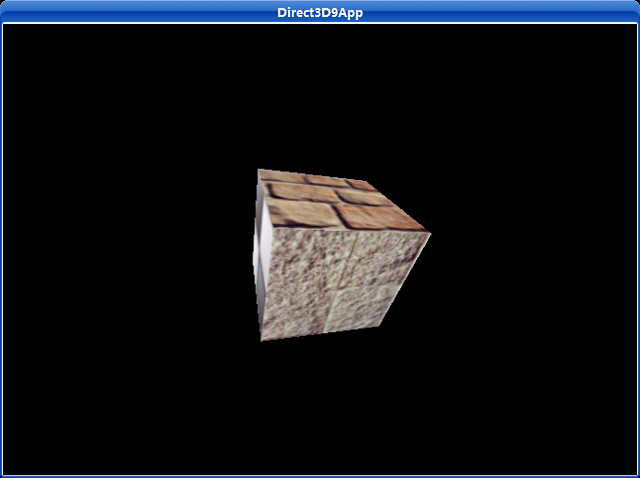D3D中的網格模型(3)
10.7 復制
有時我們需要將一個mesh中的數據拷貝到另一個mesh中,這時可以使用ID3DXBaseMesh::CloneMeshFVF方法。
|
HRESULT ID3DXMesh::CloneMeshFVF( DWORD Options, DWORD FVF, LPDIRECT3DDEVICE9 pDevice, LPD3DXMESH* ppCloneMesh ); |
Options — 用來創建mesh的一個或多個創建標志。要了解所有標志信息請查看sdk文檔。現在列出一部分:
D3DXMESH_32BIT — mesh使用32位索引。
D3DXMESH_MANAGED — mesh數據將被放在托管的內存中。
D3DXMESH_WRITEONLY — mesh數據只能執行寫操作,不能執行讀操作。
D3DXMESH_DYNAMIC — mesh緩存將是動態的。
FVF — 創建復制mesh的靈活頂點格式。
pDevice — 與復制mesh有關的設備。
ppCloneMesh — 輸出復制的mesh。
注意這個方法允許指定與原mesh不同的options和FVF。例如我們有頂點格式為D3DFVF_XYZ的mesh,現在想復制一個頂點格式為 D3DFVF_XYZ|D3DFVF_NORMAL的mesh。我們可以這樣寫:
|
// 假設_mesh和device是有效的 ID3DXMesh* clone = 0; Mesh->CloneMeshFVF( Mesh->GetOptions(), // 使用與源模型同樣的選項 D3DFVF_XYZ | D3DFVF_NORMAL,// 指定克隆的FVF Device, &clone ); |
10.8 創建一個Mesh(D3DXCreateMeshFVF)
我們可以使用D3DXCreate*函數來創建mesh物體。然而,我們也可以使用D3DXCreateMeshFVF函數來創建一個空mesh。所謂空 mesh是指我們已經指定了頂點數和面數,函數D3DXCreateMeshFVF也分配了適當大小的內存給頂點、頂點索引、屬性緩沖區。有了這些緩沖區后,就可以手動填寫上下文數據了(需要分別向頂點緩存,索引緩存、屬性緩存提供頂點、索引、屬性數據)。
我們使用D3DXCreateMeshFVF函數來創建空mesh:
|
HRESULT D3DXCreateMeshFVF( DWORD NumFaces, DWORD NumVertices, DWORD Options, DWORD FVF, LPDIRECT3DDEVICE9 pDevice, LPD3DXMESH* ppMesh ); |
NumFaces — mesh將擁有的面數。該值必須大于0。
NumVertices — mesh將擁有的頂點數。該值必須大于0。
Options —用來創建mesh的一個或多個創建標志。要了解所有標志信息請查看sdk文檔,現在列出一部分:
D3DXMESH_32BIT — mesh使用32位索引。
D3DXMESH_MANAGED — mesh數據將被放在托管的內存中。
D3DXMESH_WRITEONLY — mesh數據只能執行寫操作,不能執行讀操作。
D3DXMESH_DYNAMIC — mesh緩存將是動態的。
FVF — mesh的頂點格式。
pDevice — 與mesh相關的設備。
ppMesh — 輸出創建好的mesh。
另外,你也可以使用D3DXCreateMesh來創建空mesh。它的原型是:
|
HRESULT D3DXCreateMesh( DWORD NumFaces, DWORD NumVertices, DWORD Options, CONST LPD3DVERTEXELEMENT9* pDeclaration, LPDIRECT3DDEVICE9 pDevice, LPD3DXMESH* ppMesh ); |
這些參數和D3DXCreateMeshFVF的參數是非常相似的,除了第四個。作為替代指定的FVF,我們指定一個D3DVERTEXELEMENT9 結構,它描述了頂點格式。
|
HRESULT D3DXDeclaratorFromFVF( DWORD FVF, // input format D3DVERTEXELEMENT9 Declaration[MAX_FVF_DECL_SIZE]//output format ); |
這個函數通過輸入一個FVF返回一個D3DVERTEXELEMENT9結構的數組。注意MAX_FVF_DECL_SIZE的定義如下:< /p>
|
typedef enum { MAX_FVF_DECL_SIZE = 18 } MAX_FVF_DECL_SIZE; |
10.9 實例程序:創建和渲染Mesh
該實例程序是渲染一個立方體(如圖10.5):

它演示了這一章中的大部分功能,包括如下一些操作:
創建一個空mesh。
用一個立方體幾何信息來填充mesh。
根據mesh的每個面指定子集。
產生mesh的鄰接信息。
優化mesh。
繪制mesh。
Demonstrates how to create an empty ID3DXMesh object with D3DXCreateMeshFVF,
how to fill the vertex, index, and attribute buffers, how to optimize a mesh
and gnerate an attribute table, and how to render it.
**************************************************************************************/
#include <fstream>
#include <vector>
#include "d3dUtility.h"
#pragma warning(disable : 4100)
using namespace std;
class cTextureVertex
{
public:
float m_x, m_y, m_z;
float m_nx, m_ny, m_nz;
float m_u, m_v;
cTextureVertex() { }
cTextureVertex(float x, float y, float z,
float nx, float ny, float nz,
float u, float v)
{
m_x = x; m_y = y; m_z = z;
m_nx = nx; m_ny = ny; m_nz = nz;
m_u = u; m_v = v;
}
};
const DWORD TEXTURE_VERTEX_FVF = D3DFVF_XYZ | D3DFVF_NORMAL | D3DFVF_TEX1;
////////////////////////////////////////////////////////////////////////////////////////////////////
const int WIDTH = 640;
const int HEIGHT = 480;
IDirect3DDevice9* g_d3d_device;
ID3DXMesh* g_d3d_mesh;
IDirect3DTexture9* g_d3d_textures[3]; // texture for each subset
const DWORD g_num_subsets = 3;
ofstream g_out_file; // used to dump mesh data to file
void dump_vertices(ofstream& outFile, ID3DXMesh* mesh);
void dump_indices(ofstream& outFile, ID3DXMesh* mesh);
void dump_attribute_buffer(ofstream& outFile, ID3DXMesh* mesh);
void dump_adjacency_buffer(ofstream& outFile, ID3DXMesh* mesh);
void dump_attribute_table(ofstream& outFile, ID3DXMesh* mesh);
////////////////////////////////////////////////////////////////////////////////////////////////////
bool setup()
{
// We are going to fill the empty mesh with the geometry of a box,
// so we need 12 triangles and 24 vertices.
if(FAILED(D3DXCreateMeshFVF(12, 24, D3DXMESH_MANAGED, TEXTURE_VERTEX_FVF, g_d3d_device, &g_d3d_mesh)))
{
MessageBox(NULL, "D3DXCreateMeshFVF() - FAILED", "ERROR", MB_OK);
return false;
}
// fill in vertices of a box
cTextureVertex* v;
g_d3d_mesh->LockVertexBuffer(0, (void**)&v);
// fill in the front face vertex data
v[0] = cTextureVertex(-1.0f, -1.0f, -1.0f, 0.0f, 0.0f, -1.0f, 0.0f, 0.0f);
v[1] = cTextureVertex(-1.0f, 1.0f, -1.0f, 0.0f, 0.0f, -1.0f, 0.0f, 1.0f);
v[2] = cTextureVertex( 1.0f, 1.0f, -1.0f, 0.0f, 0.0f, -1.0f, 1.0f, 1.0f);
v[3] = cTextureVertex( 1.0f, -1.0f, -1.0f, 0.0f, 0.0f, -1.0f, 1.0f, 0.0f);
// fill in the back face vertex data
v[4] = cTextureVertex(-1.0f, -1.0f, 1.0f, 0.0f, 0.0f, 1.0f, 0.0f, 0.0f);
v[5] = cTextureVertex( 1.0f, -1.0f, 1.0f, 0.0f, 0.0f, 1.0f, 0.0f, 1.0f);
v[6] = cTextureVertex( 1.0f, 1.0f, 1.0f, 0.0f, 0.0f, 1.0f, 1.0f, 1.0f);
v[7] = cTextureVertex(-1.0f, 1.0f, 1.0f, 0.0f, 0.0f, 1.0f, 1.0f, 0.0f);
// fill in the top face vertex data
v[8] = cTextureVertex(-1.0f, 1.0f, -1.0f, 0.0f, 1.0f, 0.0f, 0.0f, 0.0f);
v[9] = cTextureVertex(-1.0f, 1.0f, 1.0f, 0.0f, 1.0f, 0.0f, 0.0f, 1.0f);
v[10] = cTextureVertex( 1.0f, 1.0f, 1.0f, 0.0f, 1.0f, 0.0f, 1.0f, 1.0f);
v[11] = cTextureVertex( 1.0f, 1.0f, -1.0f, 0.0f, 1.0f, 0.0f, 1.0f, 0.0f);
// fill in the bottom face vertex data
v[12] = cTextureVertex(-1.0f, -1.0f, -1.0f, 0.0f, -1.0f, 0.0f, 0.0f, 0.0f);
v[13] = cTextureVertex( 1.0f, -1.0f, -1.0f, 0.0f, -1.0f, 0.0f, 0.0f, 1.0f);
v[14] = cTextureVertex( 1.0f, -1.0f, 1.0f, 0.0f, -1.0f, 0.0f, 1.0f, 1.0f);
v[15] = cTextureVertex(-1.0f, -1.0f, 1.0f, 0.0f, -1.0f, 0.0f, 1.0f, 0.0f);
// fill in the left face vertex data
v[16] = cTextureVertex(-1.0f, -1.0f, 1.0f, -1.0f, 0.0f, 0.0f, 0.0f, 0.0f);
v[17] = cTextureVertex(-1.0f, 1.0f, 1.0f, -1.0f, 0.0f, 0.0f, 0.0f, 1.0f);
v[18] = cTextureVertex(-1.0f, 1.0f, -1.0f, -1.0f, 0.0f, 0.0f, 1.0f, 1.0f);
v[19] = cTextureVertex(-1.0f, -1.0f, -1.0f, -1.0f, 0.0f, 0.0f, 1.0f, 0.0f);
// fill in the right face vertex data
v[20] = cTextureVertex( 1.0f, -1.0f, -1.0f, 1.0f, 0.0f, 0.0f, 0.0f, 0.0f);
v[21] = cTextureVertex( 1.0f, 1.0f, -1.0f, 1.0f, 0.0f, 0.0f, 0.0f, 1.0f);
v[22] = cTextureVertex( 1.0f, 1.0f, 1.0f, 1.0f, 0.0f, 0.0f, 1.0f, 1.0f);
v[23] = cTextureVertex( 1.0f, -1.0f, 1.0f, 1.0f, 0.0f, 0.0f, 1.0f, 0.0f);
g_d3d_mesh->UnlockVertexBuffer();
// define the triangles of the box
WORD* index;
g_d3d_mesh->LockIndexBuffer(0, (void**)&index);
// fill in the front face index data
index[0] = 0; index[1] = 1; index[2] = 2;
index[3] = 0; index[4] = 2; index[5] = 3;
// fill in the back face index data
index[6] = 4; index[7] = 5; index[8] = 6;
index[9] = 4; index[10] = 6; index[11] = 7;
// fill in the top face index data
index[12] = 8; index[13] = 9; index[14] = 10;
index[15] = 8; index[16] = 10; index[17] = 11;
// fill in the bottom face index data
index[18] = 12; index[19] = 13; index[20] = 14;
index[21] = 12; index[22] = 14; index[23] = 15;
// fill in the left face index data
index[24] = 16; index[25] = 17; index[26] = 18;
index[27] = 16; index[28] = 18; index[29] = 19;
// fill in the right face index data
index[30] = 20; index[31] = 21; index[32] = 22;
index[33] = 20; index[34] = 22; index[35] = 23;
g_d3d_mesh->UnlockIndexBuffer();
// Specify the subset each triangle belongs to, in this example we will use three subsets,
// the first two faces of the cube specified will be in subset 0, the next two faces will
// be in subset 1 and the the last two faces will be in subset 2.
DWORD* attr_buffer;
g_d3d_mesh->LockAttributeBuffer(0, &attr_buffer);
for(int i = 0; i < 4; i++)
attr_buffer[i] = 0;
for(int i = 4; i < 8; i++)
attr_buffer[i] = 1;
for(int i = 8; i < 12; i++)
attr_buffer[i] = 2;
g_d3d_mesh->UnlockAttributeBuffer();
// optimize the mesh to generate an attribute table
vector<DWORD> adjacency_buffer(g_d3d_mesh->GetNumFaces() * 3);
g_d3d_mesh->GenerateAdjacency(0.0f, &adjacency_buffer[0]);
g_d3d_mesh->OptimizeInplace(D3DXMESHOPT_ATTRSORT | D3DXMESHOPT_COMPACT | D3DXMESHOPT_VERTEXCACHE,
&adjacency_buffer[0], NULL, NULL, NULL);
// dump the mesh data to file
g_out_file.open("Mesh Dump.txt");
dump_vertices(g_out_file, g_d3d_mesh);
dump_indices(g_out_file, g_d3d_mesh);
dump_attribute_table(g_out_file, g_d3d_mesh);
dump_attribute_buffer(g_out_file, g_d3d_mesh);
dump_adjacency_buffer(g_out_file, g_d3d_mesh);
g_out_file.close();
// create the texture and set filters
D3DXCreateTextureFromFile(g_d3d_device, "brick0.jpg", &g_d3d_textures[0]);
D3DXCreateTextureFromFile(g_d3d_device, "brick1.jpg", &g_d3d_textures[1]);
D3DXCreateTextureFromFile(g_d3d_device, "checker.jpg", &g_d3d_textures[2]);
g_d3d_device->SetSamplerState(0, D3DSAMP_MAGFILTER, D3DTEXF_LINEAR);
g_d3d_device->SetSamplerState(0, D3DSAMP_MINFILTER, D3DTEXF_LINEAR);
g_d3d_device->SetSamplerState(0, D3DSAMP_MIPFILTER, D3DTEXF_LINEAR);
// disable lighting
g_d3d_device->SetRenderState(D3DRS_LIGHTING, FALSE);
// set camera
D3DXVECTOR3 pos(0.0f, 0.f, -4.0f);
D3DXVECTOR3 target(0.0f, 0.0f, 0.0f);
D3DXVECTOR3 up(0.0f, 1.0f, 0.0f);
D3DXMATRIX view_matrix;
D3DXMatrixLookAtLH(&view_matrix, &pos, &target, &up);
g_d3d_device->SetTransform(D3DTS_VIEW, &view_matrix);
// set the projection matrix
D3DXMATRIX proj;
D3DXMatrixPerspectiveFovLH(&proj, D3DX_PI * 0.5f, (float)WIDTH/HEIGHT, 1.0f, 1000.0f);
g_d3d_device->SetTransform(D3DTS_PROJECTION, &proj);
return true;
}
///////////////////////////////////////////////////////////////////////////////////////////////////////
void cleanup()
{
safe_release<ID3DXMesh*>(g_d3d_mesh);
safe_release<IDirect3DTexture9*>(g_d3d_textures[0]);
safe_release<IDirect3DTexture9*>(g_d3d_textures[1]);
safe_release<IDirect3DTexture9*>(g_d3d_textures[2]);
}
///////////////////////////////////////////////////////////////////////////////////////////////////////
bool display(float time_delta)
{
// update: rotate the cube
static float y = 0.0f;
D3DXMATRIX x_rot_matrix, y_rot_matrix;
D3DXMatrixRotationX(&x_rot_matrix, D3DX_PI * 0.2f);
D3DXMatrixRotationY(&y_rot_matrix, y);
D3DXMATRIX world_matrix = x_rot_matrix * y_rot_matrix;
g_d3d_device->SetTransform(D3DTS_WORLD, &world_matrix);
y += time_delta;
if(y >= 6.28f)
y = 0.0f;
// render now
g_d3d_device->Clear(0, NULL, D3DCLEAR_TARGET | D3DCLEAR_ZBUFFER, 0x00000000, 1.0f, 0);
g_d3d_device->BeginScene();
for(int i = 0; i < g_num_subsets; i++)
{
g_d3d_device->SetTexture(0, g_d3d_textures[i]);
g_d3d_mesh->DrawSubset(i);
}
g_d3d_device->EndScene();
g_d3d_device->Present(NULL, NULL, NULL, NULL);
return true;
}
///////////////////////////////////////////////////////////////////////////////////////////////////////
LRESULT CALLBACK wnd_proc(HWND hwnd, UINT msg, WPARAM word_param, LPARAM long_param)
{
switch(msg)
{
case WM_DESTROY:
PostQuitMessage(0);
break;
case WM_KEYDOWN:
if(word_param == VK_ESCAPE)
DestroyWindow(hwnd);
break;
}
return DefWindowProc(hwnd, msg, word_param, long_param);
}
///////////////////////////////////////////////////////////////////////////////////////////////////////
int WINAPI WinMain(HINSTANCE inst, HINSTANCE, PSTR cmd_line, int cmd_show)
{
if(! init_d3d(inst, WIDTH, HEIGHT, true, D3DDEVTYPE_HAL, &g_d3d_device))
{
MessageBox(NULL, "init_d3d() - failed.", 0, MB_OK);
return 0;
}
if(! setup())
{
MessageBox(NULL, "Steup() - failed.", 0, MB_OK);
return 0;
}
enter_msg_loop(display);
cleanup();
g_d3d_device->Release();
return 0;
}
///////////////////////////////////////////////////////////////////////////////////////////////////////
void dump_vertices(ofstream& out_file, ID3DXMesh* mesh)
{
out_file << "Vertices:" << endl;
out_file << "---------" << endl;
cTextureVertex* v;
mesh->LockVertexBuffer(0, (void**)&v);
for(unsigned int i = 0; i < mesh->GetNumVertices(); i++)
{
out_file << "Vertex " << i << ":(";
out_file << v[i].m_x << ", " << v[i].m_y << ", " << v[i].m_z << ", ";
out_file << v[i].m_nx << ", " << v[i].m_ny << ", " << v[i].m_nz << ", ";
out_file << v[i].m_u << ", " << v[i].m_v << ")" << endl;
}
mesh->UnlockVertexBuffer();
out_file << endl << endl;
}
///////////////////////////////////////////////////////////////////////////////////////////////////////
void dump_indices(ofstream& out_file, ID3DXMesh* mesh)
{
out_file << "Indices:" << endl;
out_file << "--------" << endl << endl;
WORD* indices;
mesh->LockIndexBuffer(0, (void**)&indices);
for(unsigned int i = 0; i < mesh->GetNumFaces(); i++)
{
out_file << "Triangle " << i << ": ";
out_file << indices[i*3] << " " << indices[i*3 + 1] << " " << indices[i*3 + 2] << endl;
}
mesh->UnlockIndexBuffer();
out_file << endl << endl;
}
///////////////////////////////////////////////////////////////////////////////////////////////////////
void dump_attribute_buffer(ofstream& out_file, ID3DXMesh* mesh)
{
out_file << "Attribute Buffer:" << endl;
out_file << "-----------------" << endl << endl;
DWORD* attr_buffer;
mesh->LockAttributeBuffer(0, &attr_buffer);
// an attribute for each face
for(unsigned int i = 0; i < mesh->GetNumFaces(); i++)
out_file << "Triangle " << i << " lives in subset " << attr_buffer[i] << endl;
mesh->UnlockAttributeBuffer();
out_file << endl << endl;
}
///////////////////////////////////////////////////////////////////////////////////////////////////////
void dump_adjacency_buffer(ofstream& out_file, ID3DXMesh* mesh)
{
out_file << "Adjacency Buffer:" << endl;
out_file << "-----------------" << endl << endl;
// three entries per face
vector<DWORD> adjacency_buffer(mesh->GetNumFaces() * 3);
mesh->GenerateAdjacency(0.0f, &adjacency_buffer[0]);
for(unsigned int i = 0; i < mesh->GetNumFaces(); i++)
{
out_file << "Triangle's adjacent to triangle " << i << ": ";
out_file << adjacency_buffer[i*3] << " "
<< adjacency_buffer[i*3 + 1] << " "
<< adjacency_buffer[i*3 + 2] << endl;
}
out_file << endl << endl;
}
///////////////////////////////////////////////////////////////////////////////////////////////////////
void dump_attribute_table(ofstream& out_file, ID3DXMesh* mesh)
{
out_file << "Attribute Table:" << endl;
out_file << "----------------" << endl << endl;
DWORD num_entries; // number of entries in the attribute table
mesh->GetAttributeTable(0, &num_entries);
vector<D3DXATTRIBUTERANGE> table(num_entries);
mesh->GetAttributeTable(&table[0], &num_entries);
for(unsigned int i = 0; i < num_entries; i++)
{
out_file << "Entry " << i << endl;
out_file << "-----------" << endl;
out_file << "Subset ID: " << table[i].AttribId << endl;
out_file << "Face Start: " << table[i].FaceStart << endl;
out_file << "Face Count: " << table[i].FaceCount << endl;
out_file << "Vertex Start: " << table[i].VertexStart << endl;
out_file << "Vertex Count: " << table[i].VertexCount << endl;
out_file << endl;
}
out_file << endl << endl;
}



